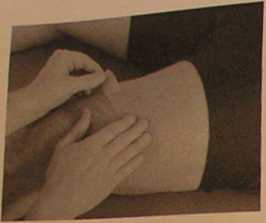P5140013

Lay down the tails of the Y with no ten-sion as the patient moves through a fuli rangę of motion. The tails should be splayed out to dissipate the tension created over as large an area as possible.
Mechanical Correction Application Technigues
Application of I Technigue, with tension in tape
Application of I Technique with tension in middle of Kinesio strip. This technique uses the application of tension in the middle of the Kinesio I Strip and downward pressure to provide a "blocking" of movement. The amount of tension and downward pressure determines the degree of "blocking".
Fascia Correction
The fascia correction is applied to create and gather fascia tissue in order to position it in a desired alignment. Tape is applied to hołd or assist fascia from unwinding from the desired position. This technique is intended to be gen tle and effect the body through the break-ing down of limitations of fascia movement by the movement of the skin and elastic qua li ties of the Kinesio Tex Tape.
Fascia is an interconnecting ma trix that connects tissues from one layer to the next and within the same layer. Itislikea3-dimen-sional spider web which li es between each layer of tissue and when there is an acute or chronić inflammation the ability of the tissue tomoveisreduced.
The proper application technique for using the elastic qualities of the Kinesio Tex Tape involve the "osdllation" of the Kinesio strip. After application of the base of the Y, the base is held to limit tension, the practitioner "ostil-lates" or vibrates the tape in a longitudinal direction during application. The "oscillates" or vibration is gentle and may include a slight downward pressure if the effects are felt to be required in deeper tissues. This is felt to limit the "recoil" effect of the tape of retuming to its original position towaids the base.

Begin by placing the center of a Kinesio I Strip, of approximately 6-8 inches, directly over the tissue to be treated. Apply moder-atetofull, 50-100 % of available tension to the middle of the strip. Place the Kinesio strip over the treatment area with tension, and downward pressure.
Use the Kinesio strip to create a "błock" to limit movement of a joint or tissue.
Have the patient move into position which place the joint, or tissue being treated in a stretched position. Lay down the ends of the Kinesio I Strip with no tension to dissipate the force added.
The photo shown has approximately 1/2 of the Kinesio I Strip over the lateral border of the patella to limit lateral tracking.
The fascia technique is applied in two I different application methods. First, use of the I elastic qualitiesof the Kinesio Tex Tape to I reposition the fascia in a desired position or in I anattempt to limit itsmovement. Second,use I the Kinesio Tex Tape to hołd the fascia in a I desired position or limit itsmovement follow-I ing application of a myofascia 1 manuał I therapy technique.
The proper application technique for using I the Kinesio Tex Tape to hołd a manuał therapy 9 technique is similar to the mechanical tech-1 nique as previously described. Following the 1 manuał therapy technique the fascia is held in I the desired position with one hand. The I Kinesio strip cut in a Y pa ttern is then applied I to hołd the tissue in the desired position. The 1 specific difference from a fascia correction to a | mechanical correction is downward pressure.
I Downward pressure is only applied when the | practitioner desires a deeper effect. Generally | the fascia correction is applied with little or no 8 downward pressure.
Wyszukiwarka
Podobne podstrony:
P5140089 lay down thc ends of the Kinesio stri tcnsion. If thc corrcctivc strip vas
P5140069 uy down the remaining Kinesio I strip withL S the above steps to form a crisscross patt^ JI
sa 15 F.xercise 13.—Triceps (Muscle at the Back of the Upper Arm) Stand with the anns down in front
break, after 7 days ~5 % of the total core graphite is oxidized, and T(fuel)-max is about the same a
IMG 140228�01 E S S A Y Garrison KeillorWalking Down the Canyon AS A CHILD, I WAS MADĘ TO LOOK OUT T
MR293R190?6 1 PRKPARIHG AND PAINTINC METHOD - Degreaee. - Rub do
24. A well is to be fracture stimulated down the production casing with the following conditions: Fr
1.1 Local Area Networks The type of Computer network to be studied in 1.1 is a single isolated LAN w
MR293R190?6 1 PRKPARIHG AND PAINTINC METHOD - Degreaee. - Rub do
68606 oak sih 3 95 and probably make a guess in the end. I will set down a few bits of this literary
71179 ss 004 MUSCLE BUILDING METHODS DOWN THE AGES STRONG MEN OF THE PAST AND PRESENT (continnecl) t
73386 ScannedImage 8 66 CONVERSATION fire, burned down the same side of his body. Tom had also tried
ss 001 Muscle Building Methods Down the AgesSTRONG MEN OF THE PAST AND PRESENTBy APOLLON V
więcej podobnych podstron